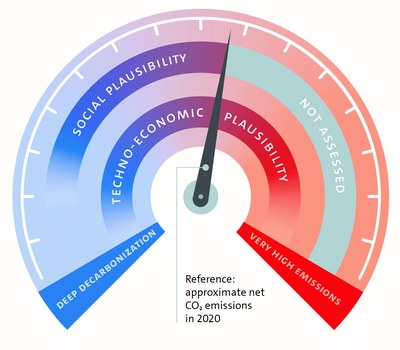10.06.2021
There are many possible futures of climate, but not all possible futures are also plausible. Because climate futures arise from a complex combination of social and physical dynamics, estimating their plausibility requires insights from multiple disciplines. This inaugural Hamburg Climate Futures Outlook makes the first systematic attempt to assess the plausibility of various climate futures. Climate futures are deemed to be plausible if they are expected to unfold with appreciable probability, given the existing evidence from the physical and social worlds.
The conclusion: Deep decarbonization by 2050 is currently not plausible – the current efforts to bring about societal transformation need to be far more ambitious.

Figure 1: Plausibility of net global CO2 emissions by 2050.
The speedometer shows the wide range of possible emissions in the year 2050 as described in existing emissions scenarios. Emissions could reach net-zero by 2050 (deep decarbonization) or could increase up to a doubling of current emissions (very high emissions). Approximate emissions in 2020 are indicated by the speedometer needle. Here we find a reduced range of plausible emissions scenarios, supported by a techno-economic plausibility assessment (Chapter 3) and a social plausibility assessment (Chapter 5), indicated by the shaded bands. Increasing emissions are not yet considered in the social plausibility assessment (gray band). ©UniHH/CLICCS
Further Information:
- The complete study is available at: https://www.cliccs.uni-hamburg.de/results/hamburg-climate-futures-outlook.html
- The Cluster of Excellence Climate, Climatic Change, and Society (CLICCS) at Universität Hamburg is funded by the German Research Foundation (DFG). Based at the Center for Earth System Research and Sustainability (CEN) at Universität Hamburg, it works in close cooperation with eleven partner institutes, including the Max Planck Institute for Meteorology in Hamburg, the Helmholtz Centre Hereon and the German Climate Computing Center.
